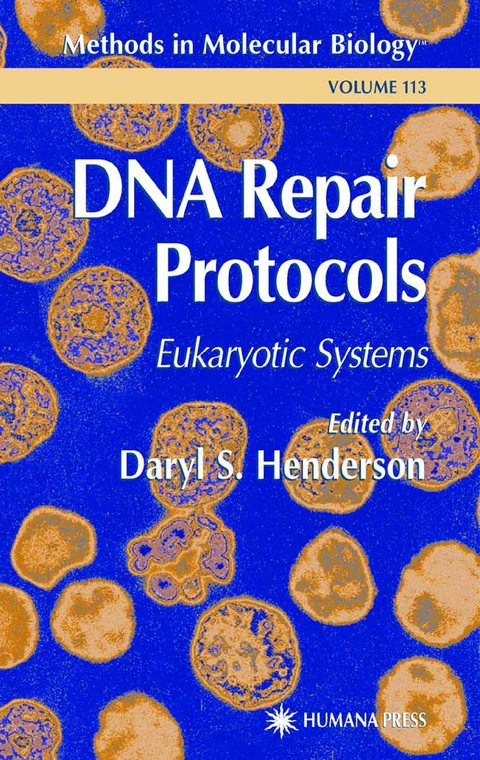
DNA Repair Protocols
Humana Press Inc. (Verlag)
978-1-61737-196-7 (ISBN)
Mutant Isolation and Gene Cloning.- Isolation of DNA Structure-Dependent Checkpoint Mutants in S. pombe.- Isolating Mutants of the Nematode Caenorhabditis elegans That Are Hypersensitive to DNA-Damaging Agents.- Isolating DNA Repair Mutants of Drosophila melanogaster.- Generation, Identification, and Characterization of Repair-Defective Mutants of Arabidopsis.- Screening for ?-Ray Hypersensitive Mutants of Arabidopsis.- Isolation of Mutagen-Sensitive Chinese Hamster Cell Lines by Replica Plating.- Strategies for Cloning Mammalian DNA Repair Genes.- Novel Complementation Assays for DNA Repair-Deficient Cells.- Recognition and Removal of Inappropriate or Damaged DNA Bases.- The Use of Electrophoretic Mobility Shift Assays to Study DNA Repair.- Mismatch Repair Assay.- Measurement of Activities of Cyclobutane-Pyrimidine-Dimer and (6-4)-Photoproduct Photolyases.- A Dot Blot Immunoassay for UV Photoproducts.- Measurement of UV Radiation-Induced DNA Damage Using Specific Antibodies.- Quantification of Photoproducts in Mammalian Cell DNA Using Radioimmunoassay.- Monitoring Removal of Cyclobutane Pyrimidine Dimers in Arabidopsis.- DNA Damage Quantitation by Alkaline Gel Electrophoresis.- The Comet Assay (Single-Cell Gel Test).- Measuring the Formation and Repair of UV Photoproducts by Ligation-Mediated PCR.- PCR-Based Assays for Strand-Specific Measurement of DNA Damage and Repair I.- PCR-Based Assays for Strand-Specific Measurement of DNA Damage and Repair II.- Gene-Specific and Mitochondrial Repair of Oxidative DNA Damage.- Characterization of DNA Strand Cleavage by Enzymes That Act at Abasic Sites in DNA.- Base Excision Repair Assay Using Xenopus laevis Oocyte Extracts.- In Vitro Base Excision Repair Assay Using Mammalian Cell Extracts.- Nucleotide Excision Repair inSaccharomyces cerevisiae Whole-Cell Extracts.- In Vitro Excision Repair Assay in Schizosaccharomyces pombe.- Nucleotide Excision Repair Assay in Drosophila melanogaster Using Established Cell Lines.- Nucleotide Excision Repair in Nuclear Extracts from Xenopus Oocytes.- Assay for Nucleotide Excision Repair Protein Activity Using Fractionated Cell Extracts and UV-Damaged Plasmid DNA.- Dual-Incision Assays for Nucleotide Excision Repair Using DNA with a Lesion at a Specific Site.- DNA Strand Breakage and Repair.- In Vitro Chemiluminescence Assay to Measure Excision Repair in Cell Extracts.- Physical Monitoring of HO-Induced Homologous Recombination.- Use of P Element Transposons to Study DNA Double-Strand Break Repair in Drosophila melanogaster.- Analyzing Double-Strand Repair Events in Drosophila.- Expression of I-Sce I in Drosophila to Induce DNA Double-Strand Breaks.- Use of I-Sce I to Induce DNA Double-Strand Breaks in Nicotiana.- Chromosomal Double-Strand Breaks Introduced in Mammalian Cells by Expression of I-Sce I Endonuclease.- Induction of DNA Double-Strand Breaks by Electroporation of Restriction Enzymes into Mammalian Cells.- In Vitro Rejoining of Double-Strand Breaks in Genomic DNA.- Extrachromosomal Assay for DNA Double-Strand Break Repair.- Use of Gene Targeting to Study Recombination in Mammalian DNA Repair Mutants.- DNA Damage Tolerance Mechanisms and Regulatory Responses.- Measurement of Low-Frequency DNA Breaks Using Nucleoid Flow Cytometry.- Live Analysis of the Division Cycles in X-Irradiated Drosophila Embryos.- Inhibition of DNA Synthesis by Ionizing Radiation.- Analysis of Inhibition of DNA Replication in Irradiated Cells Using the SV40-Based In Vitro Assay of DNA Replication.- Assays of Bypass Replication of Genotoxic Lesions in Mammalian Disease and Mutant Cell-Free Extracts.- Detection of Chromatin-Bound PCNA in Cultured Cells Following Exposure to DNA-Damaging Agents.- Induction of p53 Protein as a Marker for Ionizing Radiation Exposure In Vivo.- Activation of p53 Protein Function in Response to Cellular Irradiation.- Selective Extraction of Fragmented DNA from Apoptotic Cells for Analysis by Gel Electrophoresis and Identification of Apoptotic Cells by Flow Cytometry.- Detection of DNA Strand Breakage in the Analysis of Apoptosis and Cell Proliferation by Flow and Laser Scanning Cytometry.- Immunoassay for Single-Stranded DNA in Apoptotic Cells.
| Erscheint lt. Verlag | 10.11.2010 |
|---|---|
| Reihe/Serie | Methods in Molecular Biology ; 113 |
| Zusatzinfo | XXII, 642 p. |
| Verlagsort | Totowa, NJ |
| Sprache | englisch |
| Maße | 152 x 229 mm |
| Themenwelt | Naturwissenschaften ► Biologie ► Biochemie |
| Naturwissenschaften ► Biologie ► Mikrobiologie / Immunologie | |
| Naturwissenschaften ► Biologie ► Zellbiologie | |
| ISBN-10 | 1-61737-196-3 / 1617371963 |
| ISBN-13 | 978-1-61737-196-7 / 9781617371967 |
| Zustand | Neuware |
| Haben Sie eine Frage zum Produkt? |
aus dem Bereich


